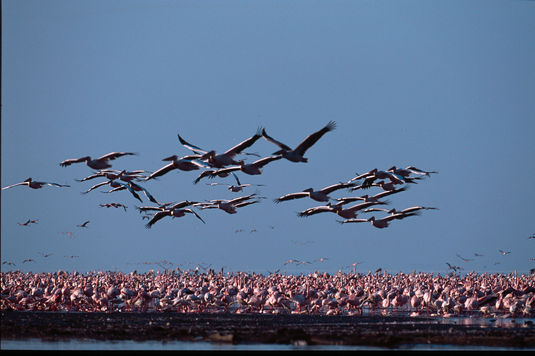
Lake Manyara National Park
Lake Manyara National Park is one of the smallest safari parks in Tanzania, but encloses within its numerous microclimates a diverse range of landscapes and animal populations which mirror those of many different parts of Tanzania in miniature. It is easily reached in 90 minutes from Arusha by road as a convenient stop-over between rival African wilderness destinations at Ngorongoro and Tarangire. Between the cliffs and the eponymous soda lake, which extends around 30 miles (50 kilometers) along the base of the 500 meter high East African Rift Valley escarpment.
Birder's Paradise
Most people visit this Rift Valley lake to view the multitude of Greater and Lesser Flamingos that wash the waters of the lake in a pink hue but there is much more to the region's birdlife than the this incredible spectacle. Dotted along the shoreline and shallows of the lake, and providing a contrast to the pink, are a collection of Storks and Pelicans - and countless other waders.
Birding at Lake Manyara is unique in that the seemingly dominant feature that is the lake is but a part of the eco-system, for this National Park in Tanzania is made up of forest, grassland, acacia woodland and the montane vegetation of the Maasai Steppes. The multitude of bird species at this lake is made up of a wide cross-section of Tanzania species, making Lake Manyara one of east Africa's birding hotspots
Birders can see Greater and Lesser Flamingo, Pelican, Cormorant, Stork, African Spoonbill or Egyptian Goose at Lake Manyara National Park in Tanzania. Other bird species include White Faced Duck, Red Billed Quelea, Long-crested Eagle, Grey-headed Kingfisher or Sacred Ibis - to name just a few of the more than 400 different bird species at this Rift Valley lake in Tanzania.
Other wildlife
Home to impudent rock-climbing klipspringer and diminutive dik-dik, there is a narrow belt of acacia woodland and area of grassland which changes seasonally from short, rich grazing lawns to golden, dry grass savannah. When green, it is colonized by wildebeests, warthogs, Cape buffalos and zebras, and when it is dry, ostrich, elephant and giraffe can be seen, the latter so dark in coloring as to look almost black in the distance. Blue and vervet monkeys, giraffe, and elephant feed
Expect to see multitudes of baboons, plenty of elephant, blue monkeys, buffalo, giraffe, zebra, tiny dik-diks and the well-known tree-climbing lions. Be sure to look up to spot them lazing in the acacia trees.
With a surprisingly diverse number of habitats in a small area – forest, grassy floodplains, the lake itself and acacia woodland – the park provides home to a wide range of animals and incredible birdlife. It’s a birdwatcher’s paradise, with a huge range of bird species, including pink-plumed flamingos and many raptors.
Staying in Manyara
Within the park, there is one luxury camp. With suites designed around the trees in a secluded, forested area of the park, this exclusive spot is the height of luxurious safari. Just outside the park, there are a number of lodges and camps that range from basic to high-end luxury.
Getting There
By Road: Lake Manyara National Park is about 150 km from Arusha (about a 2- to 3-hour drive).
By Air: Arusha is served by two airports. Arusha Airport has daily flights from numerous local destinations and Kilimanjaro International Airport has daily flights from local, African and international airlines. Flights can be booked from Arusha to Manyara Airstrip (30-minute flight).








.jpg)







